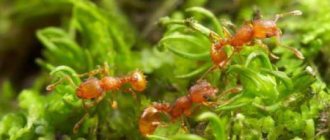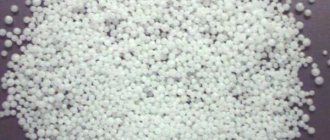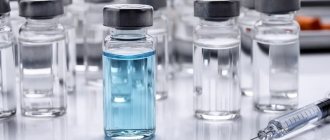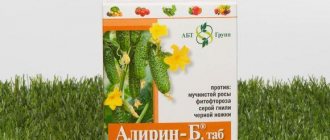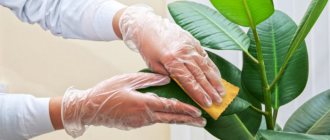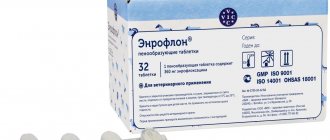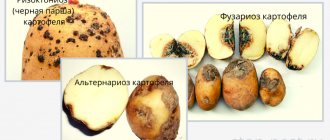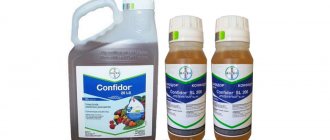A drug with a caustic name
In Soviet gardening, Nitrafen (as indicated on the packaging) was used to treat orchards and vineyards, protecting them from infections and pest invasions. They knew about the dangers of the active ingredients in the insectofungicide even then, so the dosages were strictly observed.
The chemical was also used in Europe. In the middle of the last century, Nitrafen was used to get rid of not only fungus and pests. Growth-stimulating and yield-increasing properties were noted. The drug is effective against weeds.
But in 1998, the potent pesticide was banned in the Eurozone, since chemical studies proved that the poisons remain stably in the soil for a long time. And the harm caused to humans does not cover the benefits of use.
These data were confirmed by Russian scientists: Nitrafen is stable under favorable weather conditions and provokes cancer. The drug was officially banned for use by large agricultural enterprises and private household plots.
Not allowed but available
How is it that a harmful drug is still freely sold, and dozens of websites and online stores are full of reviews from gardeners admiring the effectiveness of the poison? One of the reasons: Nitrofen is an insectofungicide that is still legally produced in the post-Soviet space.
Online stores offer domestic products. There is an opinion that Nitrafen, the production and sale of which is prohibited, is made clandestinely, since there is demand, and the price (in every sense) is not scary.
A certain percentage of the relevance of the poisonous product is explained by the impunity of manufacturers and sellers offering Nitrafen for use in the country. Although the inadmissibility of using the chemical was spoken about at the official level almost 20 years ago.
Nothing is known about measures against violators of the ban, so Nitrafen is advertised and sold to this day. Low cost and high efficiency are brought to the fore. Fortunately, the instructions usually do not forget to mention precautions when working with the drug.
Only a few self-respecting Internet resources that value their reputation go against the grain, warning gardeners about the real danger.
Unfortunately, ordinary summer residents, content with advertising information, rarely go to forums where experienced gardeners express an uncompromising opinion about agrochemicals.
Among similar reviews there are recommendations from summer residents using Nitrofen:
- After treatment, the fruits should not be eaten for at least a year, or preferably two. The measure is radical, but it was more important for the author of the comment to heal the garden.
- If it is expected that children or pets will enter the area before the end of the season, it is better to replace the toxic agent with analogues - Bordeaux mixture for early spring treatment and iron sulfate for spraying apple trees and grapes in the fall.
Nitrafen analogues
Instead of Nitrafen, its analogues can be used in gardens before buds open:
- Oleocuprite is a drug consisting of petroleum oil and copper naphthenate to combat the eggs of mites, copperheads, aphids, as well as against various spots and scabs; For spraying fruit trees and berry bushes, a solution of 400 grams of the drug in 10 liters of water is used.
- Copper sulfate is effective against the pathogens of scab, clasterosporiasis, anthracnose, septoria, various spots, a working solution of 1% concentration is used: 100 grams per 10 liters of water.
- Iron sulfate - a working solution of 2-3% concentration (200-300 grams per 10 liters of water) is used before the start of the growing season to spray fruit trees and the soil underneath them; effective against lichens and mosses, inhibits the development of spots, scab, moniliosis, fights diseases of trunks and uterine branches.
Why gardeners ignore the danger
To be fair, we note: not everyone knows about the ban on the use of Nitrafen. After all, sellers don’t talk about it. And summer residents, knowing about the danger, expect that they will be able to protect the crop if they prepare the solution correctly.
For those who dare to use an insectofungicide, we suggest that you study the description in detail, paying attention to the pros and cons of the product.
A toxic chemical, without going into details of the chemical formula, is a paste-like substance with a pungent odor. It dissolves easily in water and without sediment. Stored in polymer (usually PE) containers for up to 3 years.
Advantages
As a fungicide, Nitrafen copes with the following diseases:
- moniliosis;
- all types of rust;
- coccomycosis;
- curliness;
- spotting;
- septoria;
- powdery mildew;
- mildew;
- scab;
- anthracnose
Fungicidal properties were used to treat the trunks of fruit trees:
- the affected area was cleaned, removing tissue damaged by the fungus;
- wiped with Nitrafen.
Used as an insecticide, the drug can destroy not only adults. The poisonous effect is aimed at eggs and larvae.
The list of pests is impressive:
- aphid;
- leaf rollers;
- scale insects;
- copperheads;
- weevils;
- slugs;
- caterpillars.
According to reviews, ticks are also affected by Nitrafen, which indicates an acaricidal property.
The third function is weed suppression. She cannot cope with the concentration of poisons. By spraying woodlice or colza, summer residents got rid of excess vegetation.
Gardeners were satisfied with the compatibility of Nitrafen with other drugs:
- fungicides;
- insecticides;
- pesticides;
- fertilizers.
To save time and effort at the start of the summer season, we mixed Nitrafen with the fertilizers needed by the garden in the spring.
To get rid of any of the problems or a whole complex of them, the dacha plot was sprayed with insectofungicide once a season. Rains and temperature changes did not affect the stability of the protective film covering the branches. Nitrafen, although it is easily diluted when preparing a solution, is not washed off from plants for a long time.
The active substance remained in the ground for months, protecting against soil pests and fungi. But even at the time when Nitrafen was registered, it was not recommended to use it more than once every 3 years.
Application
Since the fungicide is dangerous for green leaves (it burns young growth), you can spray only before the buds open. The latest date in spring is a green cone (the tip of curled leaves appears between the bud scales).
The second option is autumn treatment of the garden, raspberry bushes, gooseberries, strawberry plantations, and vegetable gardens. The end of leaf fall is a signal when to treat the area. The fruits are collected, fungi and pests are preparing for winter. This is where Nitrafen covered all the parasites. Fallen leaves drenched in poison turned into a graveyard of pathogens.
Preparing for work
First, we took a small amount of liquid and diluted Nitrafen paste in it. And having achieved uniform dissolution, the volume was replenished to the required rate and poured into the sprayer. Such a simple method was another advantage of the drug.
The proportions differed for different purposes. Treatment of fruit trees, dressing the soil, treating trunks - 300 g of the drug and 10 liters of water. Consumption rate of 3% solution:
- adult apple and pear trees - 20-30 l;
- young trees and shrubs - 1 bucket.
Preventive spraying: 200 g for the same volume.
Treatment of strawberries, raspberries and other berry plantings from gray rot, roses and other ornamental garden crops from pests:
- 150 g for dilution in 10 l:
- the norm is 2 liters per bush or square meter of area.
Grapes: 200 g of paste to obtain liquid chemical.
There were also recommendations when a 10% solution was used (mixed 1 kg/10 l): before winter for spraying berry and fruit crops with severe damage from pests or fungi.
A similar concentration was used by gardeners who bought neglected plots. Of the alternatives - cutting down or etching - they preferred the second option, for which Nitrafen was used.
Risks and safety measures
Belonging to hazard class II, the drug poses a serious threat to health, and if safety precautions are not followed, even life. To avoid poisoning, the conditions under which the drug was allowed to be used were strictly observed:
- Dry, windless weather. Through the air or with streams of rainwater, Nitrafen settled where it could be accidentally “picked up” by household members or neighbors.
- Reliable protection for eyes, nose, mouth, hands. Closed clothing, boots. When undressing after treatment, gloves were removed last.
- No snacks or smoking breaks until the end of spraying, complete removal of protective equipment and clothing in which the work was carried out.
- The slightest threat of contact with an unprotected body, and especially inside, meant immediate washing of hands, eyes, and mouth with soap and running water. Before the ambulance arrived, you were supposed to drink activated charcoal.
Since the shelf life of the finished drug is zero, and it cannot be stored for any length of time, a solution was prepared in the required quantity, since it is prohibited to pour Nitrafen residues into sewers or water bodies.
Safety rules for using the insecticide "Nitrophen"
When working with pesticides, it is necessary to follow a number of certain rules so as not to get poisoned yourself, and also not to expose others to the harmful effects:
- The treatment should be carried out only in dry, windless weather, since the flying product can be harmful to others.
- When working, use a disposable polyethylene raincoat with a hood (sold in the Sadovod and Semena retail chains). After completing the procedure, it must be rolled up, placed in a plastic bag and disposed of.
- The respirator will protect the respiratory system, so use it during the entire period of use of the toxic substance.
- Rubber boots and gloves will protect the gardener's feet and hands.
- Be sure to use safety glasses to prevent the sprayed product from getting into your eyes.
- NO SMOKING! While doing the work!
- After completing the treatment, rinse the garden sprayer; it is advisable for the gardener to take a shower.
Safe legal alternative
If Anastasia, who asked a question about Nitrafen, and other law-abiding readers of our site decided not to take risks and choose other means of protection, we remind you of the names of drugs that perform the same function.
You can replace the toxic agent with copper-containing fungicides (Hom, Bordeaux mixture). Among Nitrafen substitutes, DNOC is often mentioned, which is no less effective and toxic. It is still permitted, but not for private household plots. Watch the video about using the latter:
Important! In the article, we deliberately used words in the past tense to once again emphasize: Nitrafen is yesterday's gardening. Today it is better to use agrochemicals with a lower hazard class.
What is Nitrofen: extract from the instructions for use
The manufacturer gives the following description in the specification.
- Nitrophen is a paste-like substance of thick brown color.
- A distinctive feature is good solubility in water.
- Toxicity: toxic components have no effect on humans, animals and birds.
- It is recommended to use in advance, before the leaves appear. It is forbidden to apply on foliage.
- Recommended application time: early spring or late autumn (after leaves fall)
- Used against: various types of scab, moss, lichens
- It has been shown to be effective in killing ticks, scale insects, leaf rollers and other garden pests.
Reviews
Timofey Kirillovich Boyko, Rostov region.
For the last ten years I don’t even remember about Nitrafen, although I used to process grapes, pears, cherries and even strawberries. Used only in extreme cases when other means did not help. But health is more important. It’s better to have a smaller harvest than to be poisoned by a carcinogen.
Svetlana Parshenok, Altai Territory
I agree that Nitrafen is extremely dangerous. But in terms of strength in pest control, nothing can compare. Only used once. The neighbors in the area had not yet gone out to the garden, so we were not afraid of poisoning anyone. I’ll say right away: the protective measures were unprecedented. My husband was equipped like an astronaut so that not a single drop would get in his way. After treatment, they did not appear at the dacha for a week. But the result was impressive: the season passed without problems.
Nitrafen: Use in gardening
It is necessary to spray fruit trees with Nitrafen solution before the leaves bloom, early in the spring (March-early April). It is enough to treat trees and shrubs once. Nitrophen is a very strong chemical that has successfully:
- Destroys pests overwintering in the bark of fruit trees;
- Has a detrimental effect on mites, aphids, scale insects, moths, scale insects, and leaf rollers;
- Fights diseases such as septoria, rust, clasterospora, coccomycosis, powdery mildew, scab, and other fungal diseases.
Nitrafen is also used in gardening to disinfect the soil around trees and fallen leaves in the fall. When working with the drug, you must follow safety precautions.
What Nitrafen is, as the manufacturers of the drug indicate: an insecticide, fungicide, herbicide, acaricide, a complex action drug.
Crops that can be treated with Nitrofen:
- fruit trees (apple trees, pears, cherries),
- berry bushes (gooseberries, currants),
- strawberries and strawberries.
